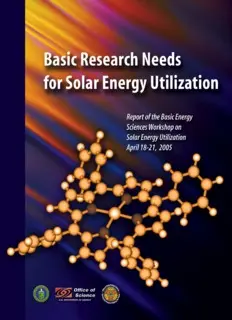
Solar Energy - Department of Chemistry PDF
Preview Solar Energy - Department of Chemistry
On the Cover: One route to harvesting the energy of the sun involves learning to mimic natural photosynthesis. Here, sunlight falls on a porphyrin, one member of a family of molecules that includes the chlorophylls, which play a central role in capturing light and using its energy for photosynthesis in green plants. Efficient light-harvesting of the solar spectrum by porphyrins and related molecules can be used to power synthetic molecular assemblies and solid- state devices — applying the principles of photosynthesis to the produc- tion of hydrogen, methane, ethanol, and methanol from sunlight, water, and atmospheric carbon dioxide. BASIC RESEARCH NEEDS FOR SOLAR ENERGY UTILIZATION Report on the Basic Energy Sciences Workshop on Solar Energy Utilization Chair: Nathan S. Lewis, California Institute of Technology Co-chair: George Crabtree, Argonne National Laboratory Panel Chairs: Solar Electric Arthur J. Nozik, National Renewable Energy Laboratory Solar Fuels Michael R. Wasielewski, Northwestern University Cross-cutting Paul Alivisatos, Lawrence Berkeley National Laboratory Office of Basic Energy Sciences Contact: Harriet Kung, Basic Energy Sciences, U.S. Department of Energy Special Assistance Technical: Jeffrey Tsao, Sandia National Laboratories Elaine Chandler, Lawrence Berkeley National Laboratory Wladek Walukiewicz, Lawrence Berkeley National Laboratory Mark Spitler, National Renewable Energy Laboratory Randy Ellingson, National Renewable Energy Laboratory Ralph Overend, National Renewable Energy Laboratory Jeffrey Mazer, Solar Energy Technologies, U.S. Department of Energy Mary Gress, Basic Energy Sciences, U.S. Department of Energy James Horwitz, Basic Energy Sciences, U.S. Department of Energy Administrative: Christie Ashton, Basic Energy Sciences, U.S. Department of Energy Brian Herndon, Oak Ridge Institute for Science and Education Leslie Shapard, Oak Ridge Institute for Science and Education Publication: Renée M. Nault, Argonne National Laboratory This report is available on the web at http://www.sc.doe.gov/bes/reports/files/SEU_rpt.pdf. CONTENTS Notation................................................................................................................................... v Executive Summary................................................................................................................ ix Introduction............................................................................................................................. 1 Global Energy Resources........................................................................................................ 7 Reports of the Panels on Basic Research Needs for Solar Energy Utilization....................... 11 Basic Research Challenges for Solar Electricity........................................................ 13 Basic Research Challenges for Solar Fuels................................................................ 33 Basic Research Challenges for Solar Thermal Utilization......................................... 57 Cross-cutting Research Challenges............................................................................. 75 Priority Research Directions................................................................................................... 89 Revolutionary Photovoltaic Devices: 50% Efficient Solar Cells............................... 91 Maximum Energy from Solar Photons at Low Cost: Designed Plastic Photovoltaic Structures......................................................................................... 101 Nanostructures for Solar Energy Conversion: Low Cost and High Efficiencies........ 109 Fuels from Water and Sunlight: New Photoelectrodes for Efficient Photoelectrolysis.................................................................................... 117 Leveraging Photosynthesis for Sustainable Solar Production of Biofuels................. 121 Using a Bio-inspired Smart Matrix to Optimize Energy Landscapes for Solar Fuels Production.......................................................................................... 127 Solar-powered Catalysts for Energy-rich Fuels Formation........................................ 135 Bio-inspired Molecular Assemblies for Integrating Photon-to-fuels Pathways......... 139 Achieving Defect-tolerant and Self-repairing Solar Conversion Systems................. 145 Solar Thermochemical Fuel Production..................................................................... 149 New Experimental and Theoretical Tools to Enable Transformational Research...... 155 Solar Energy Conversion Materials by Design........................................................... 161 Materials Architectures for Solar Energy: Assembling Complex Structures............. 171 Conclusion.............................................................................................................................. 179 Appendix 1: Technology Assessments................................................................................... 185 Solar Electricity.......................................................................................................... 187 Solar Fuels.................................................................................................................. 199 Solar Thermal and Thermoelectrics............................................................................ 213 Appendix 2: Workshop Participants....................................................................................... 229 Appendix 3: Workshop Program............................................................................................ 235 iii CONTENTS (CONT.) Appendix 4: Additional Reading............................................................................................ 249 Index....................................................................................................................................... 257 iv NOTATION ACRONYMS AND ABBREVIATIONS a-Si:H hydrogenated amorphous silicon AD anaerobic digester AEZ agro ecological zone AM air mass ASF Anderson, Schultz, and Flory BOS balance of system CB conduction band CHP combined heat and power COP coefficient of performance CPV concentrated photovoltaic dc direct current DNA deoxyribonucleic acid DNI direct normal irradiation DOE U.S. Department of Energy EFG edge-defined film-fed growth EIA Energy Information Administration EPV electrochemical photovoltaic F-T Fischer-Tropsch FTL Fischer-Tropsch liquid HCPV high-concentration photovoltaic HHV higher heating value IPCC Intergovernmental Panel on Climate Change IR infrared LFG landfill gas LH1/LH2 light-harvesting pigment/protein complexes MBE molecular beam epitaxy MEG multiple exciton generation MESP minimum ethanol selling price MOCVD metalorganic chemical vapor deposition NAE National Academy of Engineering NHE normal hydrogen electrode NRC National Research Council v OEC oxygen-evolving complex PCET proton-coupled electron transfer PCM phase change storage material PEC photoelectrochemical PEM proton exchange membrane PRD priority research directions PSI photosystem I PSII photosystem II PV photovoltaic R&D research and development RC reaction center TCO transparent conducting oxide TMS theoretical modeling and simulation TPV thermophotovoltaic U.S. United States UV ultraviolet XAFS X-ray absorption fine-structure (spectroscopy) ZT thermoelectric figure of merit UNITS OF MEASURE °C degree(s) Celsius $/kW dollar(s) per kilowatt μm micrometer(s) μs microsecond(s) Å angstrom(s) amp ampere(s) Bbl billion barrels cm centimeter(s) cm/min centimeter(s) per minute eV electron volt(s) fs femtosecond(s) gal gallon(s) Gha gigahectare(s) GJ gigajoule(s) Gtons gigatons (109 tons = 1 billion tons) GW gigawatt(s) (109 W = 1 billion watts) kg kilogram(s) kWh kilowatt hour(s) kWth kilowatt(s) (thermal) vi K Kelvin L liter(s) MHz megahertz mm millimeter(s) MW megawatt(s) (106 W = 1 million watts) MWe megawatt(s) (electric) MWth megawatt(s) (thermal) MW/yr megawatt(s) per year nm nanometer(s) nm/s nanometer(s) per second ps picosecond(s) psi pound(s) per square inch s second(s) TW terawatt(s) (1012 W = 1 trillion watts) W watt(s) W peak watt(s) p yr year(s) vii viii
